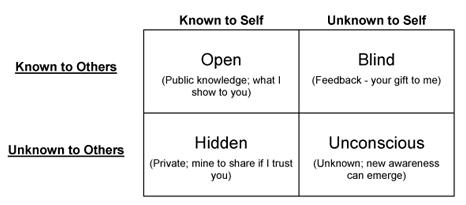Good coaching and feedback giving should help to facilitate the whole process of self-discovery. A useful model for better understanding some of the subtleties of interpersonal communication is the “Johari Window.” Named after the inventors, Joseph Luft and Harry Ingham, the Johari Window describes the process of human interaction through a paned window visual diagram. The window divides personal awareness into four different quadrants, each of which represents a different type: Open, Blind, Hidden, and Unconscious.
Open
In this quadrant, information exists that is both “known to others” and “known to self.” For example, a new coachee might share basic information about him or herself during the first coaching session, such as what they do, how long they have been doing it, previous experience and family background. This data is then in the “open” area (also referred to as the “arena”). The more an individual shares, the larger the “open” zone becomes.
Hidden
In the “hidden” quadrant exists information about an individual that has yet to be disclosed; communication that is “known to self”, but “unknown to others.” Over time, a Coachee may progressively disclose more and more about his or her “hidden” self, thus expanding the “open” quadrant and shrinking the “hidden” quadrant. Naturally, the more comfortable one feels with a particular situation, the more self-disclosure is likely to take place. Moving from the “hidden” zone is largely dependent upon mutual trust.
Blind
The “blind” area contains information that is “unknown to self”, but “known to others.” The only way to move communication from the “blind” zone to the “open” zone is through feedback. Everyone has “blind spots,” and one-on-one feedback is one way to learn more about them. The extent to which someone asks for and welcomes feedback greatly influences how likely he or she is to get it.
Unconscious
Information in this last quadrant is that which exists, but has yet to be known either by self or others. For example, a coachee may have considerable skills that he or she has not become aware of. Given the right conditions, this truth may be discovered at some point, or may not. Others may see it and share that information, or they may not. The “unconscious” quadrant represents potentiality.
Common principles between the Johari Window and other behavioural models
It is often helpful to compare the Johari Window model to other four-quadrant grid type behavioural models, notably Bruce Tuckman’s Forming, Storming, Norming, Performing team development model or also Paul Hersey’s Situational Leadership® development and management styles model. The common principle is that as the coachee matures and communications improve, so outcomes improve too, as less energy is spent on internal issues and clarifying understanding and more effort is devoted to external aims and productive output.

Colin is the Director of ResourceZone International. He has 35 years of ministry experience as a pastor, college lecturer and consultant/coach to consultants, denominational leaders and local church pastors. He can be reached at info@resourcezoneinternational.com





Comment here